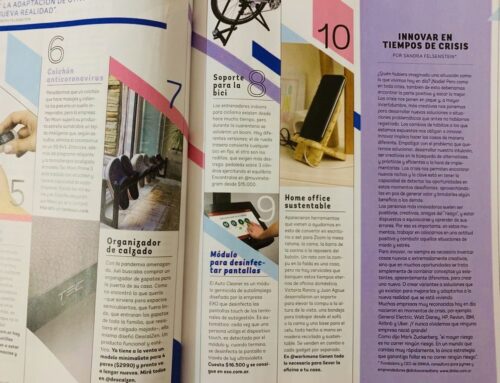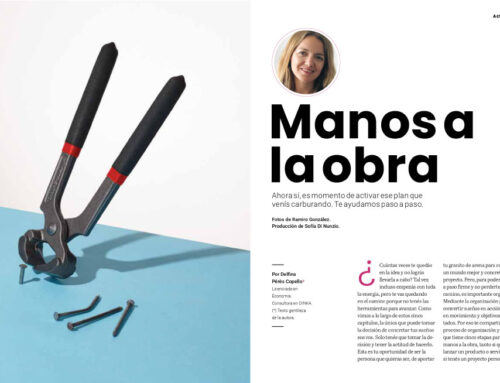In this special report we analyze the roads to access external markets. Various entities and companies detail the work philosophy for a successful export and describe the keys for the task undertaken not to frustrate.
According to a report by the Pro weaving Foundation, during 2006 exports of textile products registered a 1.2% rise compared to 2005, reaching a value of 490 million dollars. 38% of exports were destined for Mercosur countries, prlically Brazil - 142 million dollars - fundamentally in the items "cotton fabrics for towels", "Pneumatic snaps for tires" and "Polyester yarn". Then the European countries (25%), with Germany and Italy at the head by the shipments of "combing wool tops" and "dirty wool" stood out. During 2006, the highest percentage of exported products corresponds to raw materials, followed by garments and yarn, and to a lesser extent fabrics, knitting and clothing.
And regarding clothing, the Argentine Industrial Chamber of clothing (CIAI), based on data from the National Institute of Statistics and Census (INDEC) and the General Directorate of Administration) DGA), reports that clothing exports grew exponentially: in 2001 the dollar figure was US $ 31,797,759, while during 2006 it reached US $ 79,600,744. Chile, Uruguay, Spain and Brazil and to a lesser extent Mexico, Paraguay, the United States, Venezuela, Peru, Colombia, Ecuador, Bolivia, Italy, Japan and France. The main marketed products: shirts, interior cotton t -shirts, cotton panatalons, cotton shirts, swoeaters, bombs, bras, baby clothing, among others.
This radiography of what is superimposed on what could be. Many entrepreneurs express their desires to export, but by different factors they see entrepreneurship complicated. According to a survey of the Pro Team Foundation, the main reason why Argentine companies do not export is the little information about commercial opportunities and the lack of knowledge about export activity. In a second instance, the reasons are the low international prices, the tax costs, the price of inputs, the wage cost, the bureaucratic or regulatory order, the lack of financing and the high tariffs in the potential markets of destination. Let's see what roads the specialists raise to overcome some of these inconveniences.
Problems and solutions
Sandra Felsenstein, founder and director of Dinkka, a company dedicated to representing and marketing exclusive products of Argentine designers abroad, thus raises the main problem: “Being small businesses, the same people who designer, handle production and market locally and have no time or energies to take care of legal issues. Exports are a delicate topic that deserves the dedication of a lot of time, effort and knowledge. Complications when small companies want to market their products with constancy abroad.
Alejandro Vicchi, a Bachelor of Foreign Trade from Bairexport - Network of Exporters of Buenos Aires, thinks about the elements that companies should consider to export: “The clothing manufacturers are not oblivious to the common problem of all manufacturing SMEs when exporting. The main obstacles have to do with internal limitations of the firm, and there are many times those that go through the most important for the businessman. It is the lack of formal strategic planning.
When raising a path, Vicchi is committed to “the possibility of developing its own and exclusive commercial network, either through its own points of sale (which implies a high capital requirement), or through franchises, which is difficult both in the search stage of investors and from the point of view of support and control that must be carried out once in operation. Although it is not easy and it takes a long time, this path seems to Exporters, who cannot even think about installing brands through mass advertising abroad, not only for not having the necessary funds, but because the production scale and the marketing structure will never allow them to meet a demand at the necessary levels to amortize the investment. ”
From Bairexport they also understand that “to generate a medium -term export policy, companies should consider planning as a key to reduce or resolve the restrictions that the other variables pose. In general, entrepreneurs have some ambiguous goals and an intuitive roadmap but, not dumping it to the paper, many times do not analyze if what they plan to do is compatible with the few resources with which they have the small resources with which they have Journey entrepreneur to promote their products and, when returning, the emergency of the day to day of the local market prevent you from monitoring these contacts and fulfilling in a timely manner with the commitments assumed. Therefore, for Vicchi the first step of an SME that is thinking of exporting should be “to become aware that being a successful exporter takes time (a couple of years is a reasonable time to begin to see results). After that, a previous diagnosis on the company's aptitude will allow to define a list of duties or tasks that must be executed as a previous or simultaneous step to the development actions of markets abroad.
Among these previous tasks is “a preliminary market investigation, which must be told, depending on our strengths and weaknesses, in what segments and markets there are opportunities within the reach of our SME. Hence the goals and objectives of our project come out. Then it remains to define the strategy and action plans that will be developed to achieve them. Subsequently, the constant monitoring of these actions to control the fulfillment of this plan must not be forgotten.
The products
A question that is raised by any company that wishes to transpose the borders is whether or not your product will have to enter the external market. For Sandra Felsenstein, Argentine products "are accepted by design and labor." And he explains: “They are looking for typical national articles or designs that stand out from the conventional.
We are no longer as economical as before, so the price is not always very competitive by adding export expenses - import in the country of destination, freight and other associated expenses. The important thing is to look for the market niche for each product, and that they are places where they value what highlights each designer, that is, that the differential value is cited ”.
For Alejandro Vicchi, the spectrum of possibilities is broad: "There are opportunities for all sectors, to the extent that there is a differentiating factor, which may be in the design and quality of the products or in the business model. In general, the export of fashion garments and accessories shows an excellent performance in recent times, but there are also opportunities in other niches, such as sportswear and free time."
As for the modalities to access the markets, Vicchi argues that if “in the country the business model is based on the sale by own premises or franchises, it is very likely that abroad it must be operated in the same way. It is increasing The franchisor wins mainly for the provision of the merchandise to the premises, not for the fee or the value of the key (or “Fee” of admission).
Around the product that we are going to export, Felsenstein also considers vital “the quality of the proposals. And, on the other hand, the punctuality and compliance in the deliveries are fundamental, in addition to the perseverance. The same as satisfying the buyer with orders without having problems of lack of merchandise and lack of supply of raw material”. As a previous task, the director of Dinkka highlights that “in the first place it is essential to test the product locally. And then remember that whoever matters wants to obtain an important differential, whether economic or product. But something very significant is not to believe that because one markets the products abroad, it can increase the prices excessively. You do not have to forget all the associated expenses that increase the costs in an important way.”
Analyze the markets
How to choose the best destination for our exports? Alejandro Vicchi states that “it depends on the business model. In general, fashion SMEs are directed to the main consumption centers, but we must not forget that they are more competitive markets, which everyone wants They are in more advantageous conditions.
Once the target market has been decided to direct the efforts, the analysis of other factors begins. Vicchi lists the main ones: "Import tariffs, which can leave our products out of price and technical standards, to keep in mind if the product will require any certification or adaptation to enter the market (it can be a particular labeling)." Another fundamental issue is to “analyze demand trends, consumption patterns (climate, habits) and tastes of consumers, which can be seen by garments that are currently being marketed by competition and see issues such as concentration, nationality, property, location, among others.
Vicchi also emphasizes that it is very important to know the operation of seasonal seasons, when the merchants begin and in advance they decide the purchase of new collections.
Likewise, we must inquire about the events and publications of the sector to be able to make the analysis of the demand, the competition and obtain useful data for the penetration strategy. ”
International fairs
The importance of attending international fairs is an issue that nobody discusses. This is highlight by the Foundation Export: “The concentration in the same place and in a reduced period of importers, traders, distributors, agents, representative, etc., gives the employer the possibility of maximizing the number of contacts with potential buyers with a lower dispersion of efforts and a lower cost, a fact that is enhanced with multiplier effect as a result of the visit of foreign entrepreneurs who come from other countries world to know the new trends. ” The entity offers in this regard an alternative for businessmen: “After the definition of our country's commercial policy by the Argentine Foreign Ministry, based on the accumulated experience and the suggestion of Argentine diplomatic representations abroad, and its crossing with the concrete demand made by various productive sectors of our country, we elaborate the“ Calendar of official participation in international fairs ”in which those that are considered to be considered to be selected export sector of our country. The purpose of market conquest for the companies in our country is intended. ”
In Bairexport, the presence in international fairs is also considered fundamental: “It is not only important to offer its own products there, but, before that, to explore the market in situ. Concur to the main events of the sector in the region, country or city of interest will allow the employer to meet the main competitors as well as the demand trends, that is, it is equivalent to conducting a market study on the land. Consultants, partly because they find it difficult to identify consultants who know the item and offer good quality services at a cost they can pay.
visit and be visited
Commercial missions are an activity that can also be very useful to promote an exportable offer. Alejandro Vicchi describes that “an example is the delegations of SMEs that travel together coordinated by some institution, to meet with possible or buyers or representatives. In some cases, the missions are directed towards sector events (such as a fashion week), other times they include show-works or armed to hoc parades to exhibit the products of the members of the delegation, and on other occasions they simply are simply. of his interest, based on an agenda previously concerted by the Argentine embassy in that destination. ” In any case Vicchi emphasizes that “the advantage of a commercial mission lies, in the first place, that institutional support, events, technical assistance and travel cost reductions that would not be achieved individually can be managed. In addition, when integrating a group of entrepreneurs there is the possibility of exchanging experiences, useful data and collaborating reciprocally to make the most of the experience. A multisectoral can be equally useful.
The Courtfall of the trip abroad are the rounds of international buyers or reverse missions. For the Foundation to export this alternative “it has been transformed into an attractive and economical commercial promotion tool for SMEs and in particular for those who see an obstacle a trip abroad or contact with importers. During this year we have already organized eight rounds, of which more than 350 local and 55 foreign companies participated.
As for the contact mechanism, the entity suggests: "since those interested in local products come to the country for a short time, and will have a meeting after another that does not exceed 40 minutes, it is transcendental that this meeting is as productive as possible." And to achieve this, it lists some requirements: "In the first place, we suggest working on the product to be consistent with international quality standards, price, etc. Then we recommend working on who the buyer is, to increase the probabilities of reaching a mutually convenient agreement during the meeting. It is important to know the situation of our products regarding national and international competition. For this it is necessary to make a comparative analysis of our product or service from a critical and realistic order Prima, tradition or trajectory of the company or the product, image of the country or the sector, the position of the company within the national market ”.
From these premises, the round of buyers "is an excellent opportunity to begin the relationship with potential buyers. To open a relationship, not to close a contract. In this way, the time you have will be more fertile."
From Dinkka this mechanism is also analyzed as very positive. But Sandra Felsenstein emphasizes that "it is important to select the participants very well so that accurate marketing possibilities can be completed. In addition, the subsequent contact of the seller is crucial so that the buyer sees the interest and perseverance to maintain constancy in the commercial relationship."
The most coveted destinations
Accessing the most powerful markets always constitutes an attraction for exporters, but the task will be arduous. From Bairexport they analyze it in this way: "We must bear in mind that the United States, the European Union and Japan are the most wanted markets for the volume of demand and purchasing capacity, and this leads to companies from all other countries wanting to sell. And they exemplify even more: “It is very common that when an exporter requests a meeting from a distributor located in the European Union, he wants to know some specific data in advance to decide based on that whether or not to receive the visitor.
Traditionally they want to be informed of estimated prices of the products already placed in the place of destination, delivery period from the issuance of the purchase order until reception in the buyer deposit and, if appropriate, if the product is already enabled for free sale or meets the technical requirements (such as CE standards). Depending on this response, communication may conclude at that point with a strict negative or that your interest is awakened and ask for the meeting. ”Vicchi adds that“ in general buyers analyze all the proposals received, they begin to negotiate and thus determine which product lines will work in the next season. If they consider that they already have enough proposals to select, or if they already completed that process, it is difficult for them to decide to give an interview to an offeror who did not arrive at the right time. This does not mean that one should be discouraged. The important thing is to have reasonable expectations, determine - according to the business model - what is the strategy and what is the profile of the indicated counterpart. In short, to access these markets the effort that is needed is proportional to the result you want to achieve. Previous preparation and the ability to continue the contact of contacts during a certain period, which can reach two years, are always key aspects that define whether the development of a market ends up paying fruit.








